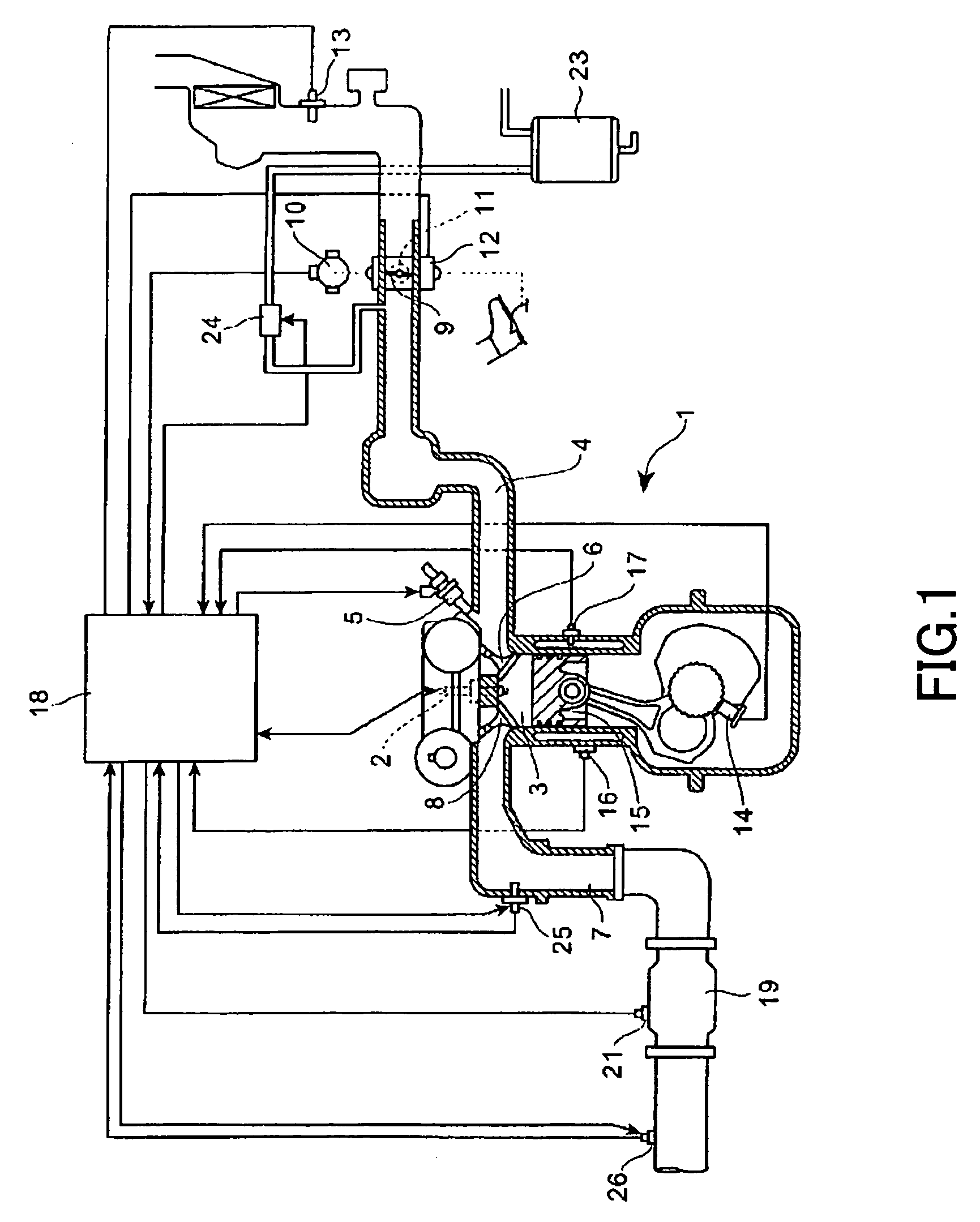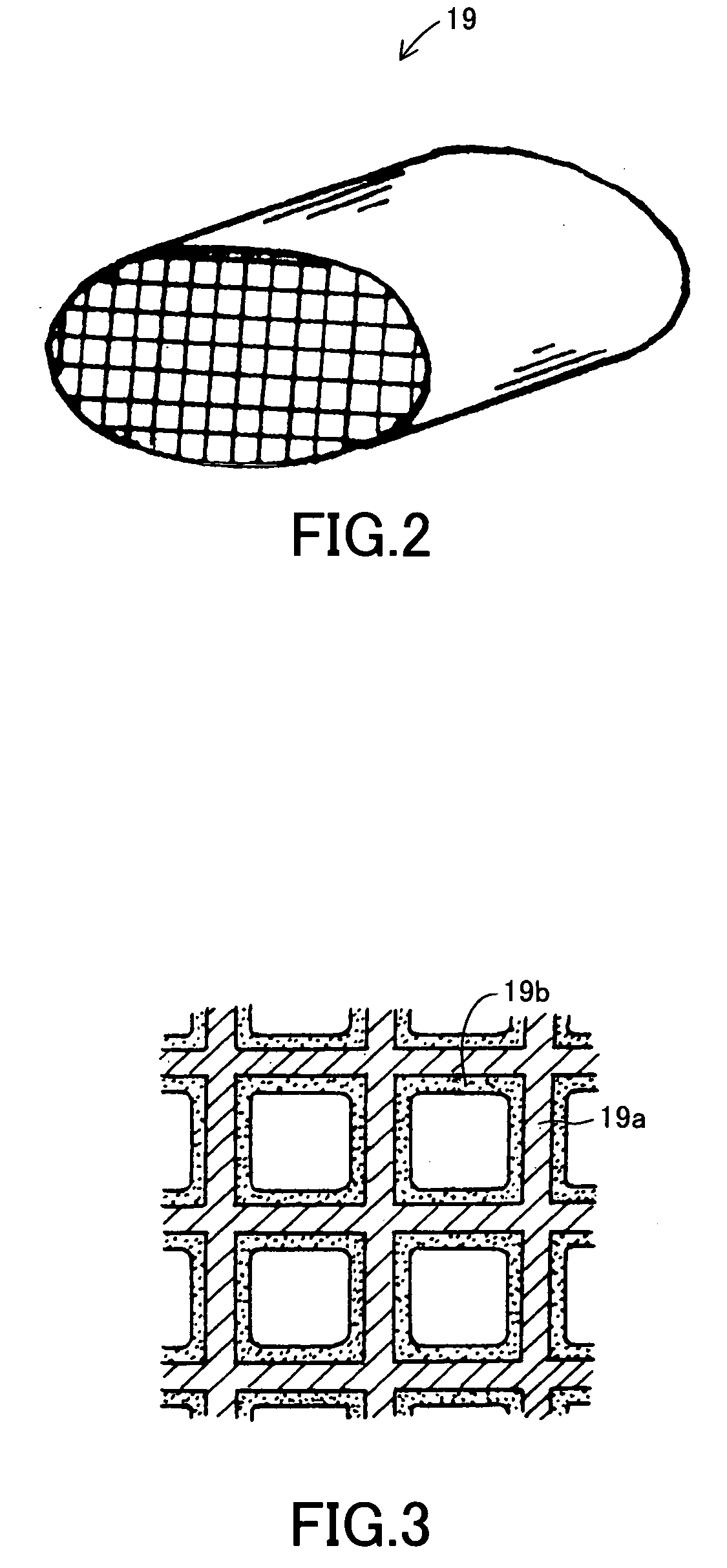Air-fuel ratio control apparatus for internal combustion engine
- Summary
- Abstract
- Description
- Claims
- Application Information
AI Technical Summary
Benefits of technology
Problems solved by technology
Method used
Image
Examples
first embodiment
[0207]First, a first embodiment will be described with reference to FIG. 18, which shows a control flowchart thereof. In the present embodiment, the amount of oxygen in exhaust gas (in actuality, the concentration of oxygen discharged from the catalyst unit 19) and the amount of carbon monoxide in the exhaust gas (in actuality, the concentration of carbon monoxide discharged from the catalyst unit 19) are obtained as the above-described estimation values. Further, in air-fuel ratio control, oxygen amount is handled as an excess or deficient amount of oxygen. That is, when oxygen is present in an excessive amount, the oxygen amount assumes a positive value, and when oxygen is deficient, the oxygen amount assumes a negative value. Moreover, in the present embodiment, the entirety of the catalyst unit 19 is considered to be a single region (specific region).
[0208]In the exhaust gas purification reaction at the catalyst unit 19, oxygen is consumed in order to oxidize a to-be-removed com...
second embodiment
[0217]Next, a second embodiment will be described with reference to FIG. 20, which shows a control flowchart thereof. In the present embodiment, rich and lean components of the exhaust gas are used as the above-described estimation values. Further, in the present embodiment, the entirety of the catalyst unit 19 is considered to be a single region (specific region).
[0218]The rich component collectively refers to components whose contents in the exhaust gas increase when the exhaust air-fuel ratio is on the rich side, and is one representative value that shows the state of the exhaust gas flowing out of the catalyst unit 19. Specifically, it is a representative value that serves a collective index representing the amounts of CO and HC contained in the exhaust gas. Meanwhile, the lean component collectively refers to components whose contents in the exhaust gas increase when the exhaust air-fuel ratio is on the lean side, and is one representative value that shows the state of the exha...
third embodiment
[0228]Next, a third embodiment will be described with reference to FIG. 21, which shows a control flowchart thereof. In the present embodiment, emissions (in actuality, concentrations) of oxygen, carbon monoxide, and nitrogen monoxide contained in exhaust gas are used as the above-described estimation values. Further, in the present embodiment, the entirety of the catalyst unit 19 is considered to be a single region (specific region). In the present embodiment, since air-fuel ratio control is performed by use of the above-mentioned three estimation values, in the following description, Cgout in relation to oxygen emission is represented by CgoutO2 (Cgout,O2) , Cgout in relation to carbon monoxide emission is represented by CgoutCO (Cgout,CO), and Cgout in relation to nitrogen monoxide emission is represented by CgoutNO (Cgout,NO).
[0229]As shown in the flowchart of FIG. 21, in the first step, step 140, the CPU estimates CginR (Cgin,CO) and CginL (Cgin,O2, Cgin,NO) of the rich and lea...
PUM
 Login to View More
Login to View More Abstract
Description
Claims
Application Information
 Login to View More
Login to View More - R&D
- Intellectual Property
- Life Sciences
- Materials
- Tech Scout
- Unparalleled Data Quality
- Higher Quality Content
- 60% Fewer Hallucinations
Browse by: Latest US Patents, China's latest patents, Technical Efficacy Thesaurus, Application Domain, Technology Topic, Popular Technical Reports.
© 2025 PatSnap. All rights reserved.Legal|Privacy policy|Modern Slavery Act Transparency Statement|Sitemap|About US| Contact US: help@patsnap.com



